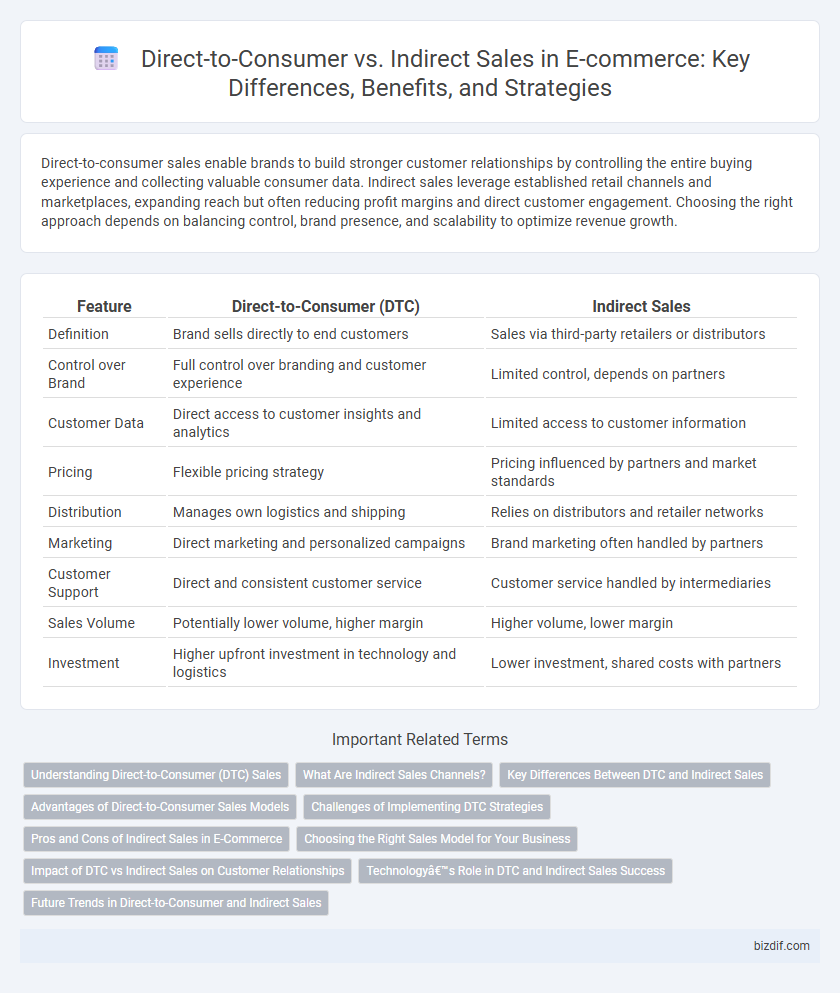Direct-to-consumer sales enable brands to build stronger customer relationships by controlling the entire buying experience and collecting valuable consumer data. Indirect sales leverage established retail channels and marketplaces, expanding reach but often reducing profit margins and direct customer engagement. Choosing the right approach depends on balancing control, brand presence, and scalability to optimize revenue growth.
Table of Comparison
| Feature | Direct-to-Consumer (DTC) | Indirect Sales |
|---|---|---|
| Definition | Brand sells directly to end customers | Sales via third-party retailers or distributors |
| Control over Brand | Full control over branding and customer experience | Limited control, depends on partners |
| Customer Data | Direct access to customer insights and analytics | Limited access to customer information |
| Pricing | Flexible pricing strategy | Pricing influenced by partners and market standards |
| Distribution | Manages own logistics and shipping | Relies on distributors and retailer networks |
| Marketing | Direct marketing and personalized campaigns | Brand marketing often handled by partners |
| Customer Support | Direct and consistent customer service | Customer service handled by intermediaries |
| Sales Volume | Potentially lower volume, higher margin | Higher volume, lower margin |
| Investment | Higher upfront investment in technology and logistics | Lower investment, shared costs with partners |
Understanding Direct-to-Consumer (DTC) Sales
Direct-to-Consumer (DTC) sales enable manufacturers to sell products directly to customers, eliminating intermediaries and increasing profit margins. This model enhances control over brand messaging, customer experience, and data collection, enabling personalized marketing and faster feedback loops. Companies leveraging DTC benefit from stronger customer loyalty, improved inventory management, and streamlined supply chains in the competitive e-commerce landscape.
What Are Indirect Sales Channels?
Indirect sales channels in e-commerce involve intermediaries such as wholesalers, retailers, or third-party online marketplaces that sell products on behalf of the brand. These channels expand market reach by leveraging established networks and customer bases, often reducing the burden of inventory management and logistics. Utilizing indirect sales channels can lead to increased brand exposure and access to diverse consumer segments that might be difficult to reach through direct-to-consumer efforts alone.
Key Differences Between DTC and Indirect Sales
Direct-to-Consumer (DTC) sales involve brands selling products directly to customers through their own online stores, enabling full control over branding, pricing, and customer experience. Indirect sales rely on third-party retailers or marketplaces, which can expand reach but often reduce profit margins and limit control over customer data. Key differences include ownership of customer relationships, marketing control, and data accessibility, making DTC ideal for brand loyalty while indirect sales excel in broader market penetration.
Advantages of Direct-to-Consumer Sales Models
Direct-to-consumer (DTC) sales models enable brands to maintain full control over customer experience and data, fostering stronger brand loyalty and personalized marketing strategies. By eliminating intermediaries, companies increase profit margins and accelerate feedback loops, allowing rapid product innovation and adaptation to market trends. Enhanced customer insights derived from direct interactions support tailored promotions and inventory management, optimizing operational efficiency and driving long-term growth.
Challenges of Implementing DTC Strategies
Implementing Direct-to-Consumer (DTC) strategies faces significant challenges such as high upfront investment in technology infrastructure, customer acquisition, and fulfillment logistics. Brands encounter difficulties managing supply chain complexities and maintaining personalized customer experiences without intermediary support. Data privacy regulations and evolving consumer expectations further complicate DTC execution and scalability in competitive e-commerce markets.
Pros and Cons of Indirect Sales in E-Commerce
Indirect sales in e-commerce leverage third-party marketplaces and retailers, expanding brand exposure and access to broader customer bases without the overhead of managing individual customer relationships. However, this approach often results in lower profit margins due to retailer commissions and less control over brand messaging and customer experience. Reliance on intermediaries can also lead to inventory and pricing conflicts, challenging consistent brand positioning and customer loyalty development.
Choosing the Right Sales Model for Your Business
Direct-to-consumer (DTC) sales offer businesses greater control over brand messaging and customer data, enabling personalized marketing and higher profit margins. Indirect sales models leverage established retail or distributor networks to rapidly expand reach and scale without heavy investments in customer acquisition. Evaluating factors such as target audience, budget constraints, and long-term brand strategy helps determine whether DTC or indirect sales best align with your business goals.
Impact of DTC vs Indirect Sales on Customer Relationships
Direct-to-Consumer (DTC) sales enable brands to establish stronger, personalized customer relationships through direct communication and data collection, enhancing customer loyalty and satisfaction. Indirect sales rely on intermediaries, which often dilute brand messaging and limit access to customer insights, hindering personalized marketing efforts. The increased control in DTC channels drives deeper engagement, allowing brands to tailor experiences based on real-time consumer behavior and feedback.
Technology’s Role in DTC and Indirect Sales Success
Technology multiplies the efficiency of Direct-to-Consumer (DTC) models through advanced customer relationship management (CRM) systems, personalized marketing automation, and data analytics that tailor user experiences and optimize conversion rates. Indirect sales channels leverage technology for inventory management, supply chain integration, and streamlined communication with distributors, enhancing product availability and market reach. Both models utilize e-commerce platforms and digital payment solutions, but DTC's success hinges on robust digital tools to directly engage and retain customers while indirect sales benefit from technology that supports partner collaboration and scalability.
Future Trends in Direct-to-Consumer and Indirect Sales
Direct-to-Consumer (DTC) sales are poised to leverage advanced AI-driven personalization and AR technology to create immersive shopping experiences, significantly enhancing customer engagement and retention. Indirect sales channels will increasingly integrate omnichannel strategies and data analytics to optimize inventory management and improve partner collaboration. Both models are expected to adopt sustainable practices and blockchain for transparent supply chains, reshaping trust and efficiency in e-commerce.
Direct-to-Consumer vs Indirect Sales Infographic

 bizdif.com
bizdif.com